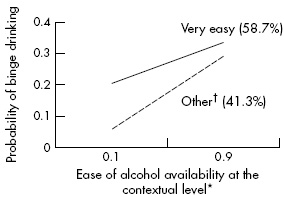Is there any correlation between the presence of prevention measures and a decrease in substance use behavior? In their study about college youth smoking risks, Weitzman et al. also examine the correlation between binge drinking risks, ease of alcohol purchase, and college campus prevention policies (Weitzman, Chen, & Subramanian, 2005).
Data Collection/Participants
- Researchers used data from the 2001 Harvard School of Public Health College alcohol study (HSPH-CAS)(Wechsler, Davenport, Dowdall, Moeykens, & Castillo, 1994; Wechsler et al., 2002)
- Total N = 10, 924 randomly selected full time undergraduate college students
- 2001 survey had a 50% general response rate
- Researchers asked participants to think about their drinking during the past two weeks using a gender-based definition of binge drinking:
- Five or more drinks on one occasion for males
- Four or more drinks on one occasion for females
- Specific definitions of “one drink” were provided in the HSPH-CAS Survey
Results

Figure 1. Ease of alcohol availability at the contextual level vs Probability of binge drinking. *Cross Level interaction p<0.05 (adapted from Weitzman et al., 2005). Click image to enlarge.
Figure 2. Policy enforcement at the contextual level vs Probability of binge drinking. *Cross Level interaction p<0.05 (adapted from Weitzman et al., 2005). Click image to enlarge.
- Prevalence of students who report binge drinking during the last two weeks = 42.9%
- Researchers found:
- A positive correlation between alcohol availability and binge drinking
- Schools where students said alcohol was easy to obtain had a binge drinking rate of 52.4%
- A negative correlation between policy enforcement and binge drinking
- For schools whose alcohol restriction policies were described as “strongly enforced” the binge drinking rate was 44.4%
- A negative correlation between parental notification and binge drinking
- Schools “very likely” to notify parents of students caught using a fake ID had the lowest binge drinking rate (26.9 %)
Limitations
- Researchers used an anonymous mail-in self-report survey
- The response rate of 50% is lower than in previous years.
- The low response rates indicate possible bias within the data.
Conclusions
Weitzman et al’s study, found that the perception of strong alcohol regulation policy enforcement limited binge drinking. Parental notification of violations had the most pronounced effect on lowering binge drinking rates. The results suggest that colleges are not powerless to affect student behaviors, especially with regard to substance use. The implementation of regulatory policy and strict consequences to excessive substance use are a step in the right direction to prevent substance related problems.
—Ingrid R. Maurice
What do you think? Please use the comment link below to provide feedback on this article.
References
Wechsler, H., Davenport, A., Dowdall, G., Moeykens, B., & Castillo, S. (1994). Health and behavioral consequences of binge drinking in college. A national survey of students at 140 campuses. Jama, 272(21), 1672-1677.
Wechsler, H., Lee, J. E., Kuo, M., Seibring, M., Nelson, T. F., & Lee, H. (2002). Trends in college binge drinking during a period of increased prevention efforts. Findings from 4 Harvard School of Public Health College Alcohol Study surveys: 1993-2001. J Am Coll Health, 50(5), 203-217.
Weitzman, E. R., Chen, Y. Y., & Subramanian, S. V. (2005). Youth smoking risk and community patterns of alcohol availability and control: a national multilevel study. J Epidemiol Community Health, 59(12), 1065-1071.





